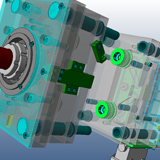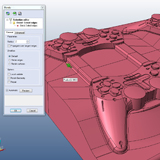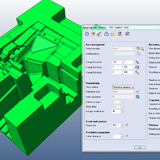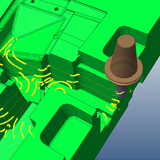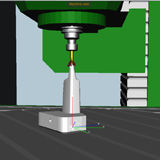German Preview of VISI 21 At Euromold
Major enhancements in the forthcoming release of VISI 21, from Vero Software, will be on display for the first time in Germany at the Euromold Exhibition in Frankfurt (25.11.2014 - 28.11.2014, Hall 8, Stand K70). Due to be released in November, VISI 21 includes 340+ product enhancements and a continued emphasis on intelligent solutions for mould making and stamping die industries.
Updated CAD developments include a new process for managing multiple instances of the same geometry within an assembly. For example, multi-insert moulds and dies can now be managed with a single ‘master’ part which will automatically update all references of the same geometry if any part modification is required. Importantly, standard catalogue components will also be managed by the multi-instance technology. The forthcoming release also includes motion study simulation tools allowing the user to define timelines which control the movement for various groups of components. The physical interaction of model geometry can be detected and the results of complex mechanisms simulated and investigated - ideal when validating the tool design and checking for potential collisions with slides, cams and lifters.
Other CAD highlights include Part Revision Management, where it is now possible to manage model changes after they have been released to manufacture. A revision history is automatically created when a model has been released with the model geometry automatically locked. Any change to a released model will create a copy of the data and update the revision number; providing a history track and ensuring part manufacture is always up to date.
VISI 21 represents a release with significant CAM focus, including a fresh new look to the CAM Navigator, command consolidation, and new dialogue box consistency within all milling operations, dramatically simplifying toolpath generation. Feature tree grouping, management of multiple setups/features along with drag & drop capabilities within the tree, make the feature list and navigation extremely efficient. All features in the tree can be moved, edited, mirrored, and with a new dedicated “undo” mechanism for CAM, user mistakes can be easily rectified.
Version 21 introduces the next generation of CAM toolpaths for VISI machining. As with the GUI, 2D milling operations have been consolidated and include a host of new options. A new ‘complex feature’ allow the users to define geometry to machine that have a complex side wall and island wall section shape. Typically requiring 3D strategies, the new ‘complex feature’ means that standard 2D operations can be applied. Re-machining on a 2D toolpath is another highlight, where a simple milling operation now bases all the re-machining on the previous operation. This means that all the correct areas are machined, even on the flat areas of the toolpath. Full collision checks on all lead-in and retract movements ensure 2D toolpaths are more efficient than ever.
The GUI layout for 3D milling operations now shares a similar format to that of the 2D CAM toolpaths. For example, the clearance area and oversize settings in the 3D operations will be in the same location as those in 2D operations, and vice versa. The overall quality of the surface finish is a major point for VISI 21 with significantly improved point distribution and enhanced accuracy. To complement the new 2D and 3D toolpath developments, a new G-code simulator provides users with an accurate virtual representation of the part, before committing it to the machine. The quality and accuracy of the model representation has been improved along with the number of axes that can be simulated. For true NC code checking, an extra option is available to simulate the real posted NC files from the toolpath. All the relevant G-codes, M-codes and moves are simulated against the real machine model to ensure that the NC file run on the machine will be 100% accurate.
Wire EDM developments include the introduction of smart operations which analyse the feature geometry and determine the best method of cutting. Other enhancements include the addition of multiple slug retention methods and ‘manual moves’, which can be added into a work sequence to reposition the nozzles to avoid fixtures or move from one cut to another.






